Geochemical, Isotopic and Petrological Constraints on the Origin and Evolution of the Recent Silicic Magmatism of the Greater Caucasus
Abstract
:1. Introduction
2. Geological Relations and Magmatism Ages
3. Samples and Analytical Methods
4. Results
4.1. Petrography and Mineralogy
4.1.1. Rhyolites of Chegem Caldera (2.9 Ma)
4.1.2. Early (Lower) Rhyolites of Elbrus and Rhyolites of Tyrnyauz (1.98 Ma)
4.1.3. Late (Upper) Rhyolites of Elbrus
4.1.4. Dacitic Lavas of Elbrus
4.1.5. Eldjurta Granite (Tyrnyauz)
4.2. Bulk Rock Composition
4.3. Oxygen Isotopic Composition
5. Discussion
5.1. Early Elbrus Rhyolites, Tyrnyauz Rhyolites, and Eldjurta Granites
5.2. The 1.98 Ma Ignimbrites in the Basement of Elbrus Area and Chegem Rhyolites (2.9 Ma)
5.3. Origin of Rhyolite Magmas of the Greater Caucasus
5.4. Reasons for Th and U Enrichment and High Th/U Ratios
5.5. Origin of Isotopic Characteristics
5.5.1. Role of Mantle Source Enrichment
5.5.2. Role of Crustal Assimilation
5.6. Origin of Young Ignimbrites and Lavas of Elbrus Area
6. Conclusions
Supplementary Materials
Author Contributions
Funding
Data Availability Statement
Acknowledgments
Conflicts of Interest
References
- Pearce, J. Sources and settings of granitic rocks. Episodes 1996, 19, 120–125. [Google Scholar] [CrossRef] [Green Version]
- Moyen, J.-F.; Laurent, O.; Chelle-Michou, C.; Couzinié, S.; Vanderhaeghe, O.; Zeh, A.; Villaros, A.; Gardien, V. Collision vs. Subduction-Related Magmatism: Two Contrasting Ways of Granite Formation and Implications for Crustal Growth. Lithos 2017, 277, 154–177. [Google Scholar] [CrossRef] [Green Version]
- France-Lanord, C.; Le Fort, P. Crustal Melting and Granite Genesis during the Himalayan Collision Orogenesis. Earth Environ. Sci. Trans. R. Soc. Edinb. 1988, 79, 183–195. [Google Scholar] [CrossRef]
- Azizi, H.; Asahara, Y. Juvenile Granite in the Sanandaj–Sirjan Zone, NW Iran: Late Jurassic–Early Cretaceous Arc–Continent Collision. Int. Geol. Rev. 2013, 55, 1523–1540. [Google Scholar] [CrossRef]
- Li, X.; Li, W.; Wang, X.; Li, Q.; Liu, Y.; Tang, G. Role of Mantle-Derived Magma in Genesis of Early Yanshanian Granites in the Nanling Range, South China: In Situ Zircon Hf-O Isotopic Constraints. Sci. China Ser. D Earth Sci. 2009, 52, 1262–1278. [Google Scholar] [CrossRef]
- Soesoo, A. Fractional Crystallization of Mantle-Derived Melts as a Mechanism for Some I-Type Granite Petrogenesis: An Example from Lachlan Fold Belt, Australia. J. Geol. Soc. 2000, 157, 135–149. [Google Scholar] [CrossRef]
- Minanovskiy, E.E.; Koronovsky, N.V. Orogenic Volcanism and Tectonics of the Alpine Belt of Eurasia; Nauka: Moscow, Russia, 1973. [Google Scholar]
- Grün, R.; Tani, A.; Gurbanov, A.; Koshchug, D.; Williams, I.; Braun, J. A New Method for the Estimation of Cooling and Denudation Rates Using Paramagnetic Centers in Quartz: A Case Study on the Eldzhurtinskiy Granite, Caucasus. J. Geophys. Res. Solid Earth 1999, 104, 17531–17549. [Google Scholar] [CrossRef]
- Lipman, P.W.; Bogatikov, O.A.; Tsvetkov, A.A.; Gazis, C.; Gurbanov, A.G.; Hon, K.; Koronovsky, N.V.; Kovalenko, V.I.; Marchev, P. 2.8-Ma Ash-Flow Caldera at Chegem River in the Northern Caucasus Mountains (Russia), Contemporaneous Granites, and Associated Ore Deposits. J. Volcanol. Geotherm. Res. 1993, 57, 85–124. [Google Scholar] [CrossRef]
- Gazis, C.A. An Isotopic Study of the Fluid Flow and Thermal History of the 2.8 Ma Chegem Ash-Flow Caldera and Related Intrusive Rocks. Ph.D. Thesis, California Institute of Technology, Caucasus Mountains, Russia, 1995. [Google Scholar]
- Myshenkova, M.S. Geological Position, Composition, Age and Genesis Pliocene-Quaternary Silicic Volcanics of Elbrus Volcanic Region (North Caucasus). Ph.D. Thesis, Moscow State University, Moscow, Russia, 2021. [Google Scholar]
- Kostitsyn, Y.A.; Kremenetsky, A.A. Age of Final Magmatic stage of the Eldjurtu Granite: Rb–Sr Isochron Dating of Aplites. Geokhimiya 1995, 7, 925–932. [Google Scholar]
- Koronovsky, N.V.; Myshenkova, M.S. Structure of the western slope of Elbrus volcano and Elbrus area. Geol. Geophys. South Russ. 2016, 6, 60–73. [Google Scholar]
- Bogatikov, O.A.; Gurbanov, A.G.; Koshchug, D.G.; Gazeev, V.M.; Shabalin, R.V.; Dokuchaev, A.Y.; Melekestsev, I.V.; Sulerzhitskii, L.D. Main Evolutionary Phases of Elbrus Volcano (Northern Caucasus, Russia) Based on EPR Dating of Quartz. J. Volcanol. Seismol. 2003, 3, 3–14. [Google Scholar]
- Gazeev, V.M. Petrology and Potential Ore Prospects of Elbrus Volcanic Center. Extended Abstract of Cand Sci (Geol-Miner); IGEM RAS: Moscow, Russia, 2003. [Google Scholar]
- Koshchug, D.G.; Solovyov, Y.P. Accumulation of Structural Radiation Defects in Quartz in Cooling Systems: Basis for Dating. Phys. Chem. Miner. 1998, 25, 242–248. [Google Scholar] [CrossRef]
- Bindeman, I.N.; Colón, D.P.; Wotzlaw, J.-F.; Stern, R.; Chiaradia, M.; Guillong, M. Young Silicic Magmatism of the Greater Caucasus, Russia, with Implication for Its Delamination Origin Based on Zircon Petrochronology and Thermomechanical Modeling. J. Volcanol. Geotherm. Res. 2021, 412, 107173. [Google Scholar] [CrossRef]
- Gurbanov, A.G.; Gazeev, V.M.; Bogatikov, O.A.; Dokuchaev, A.Y.; Naumov, V.B.; Shevchenko, A.V. Elbrus Active Volcano and Its Geological History. Russ. J. Earth Sci. 2004, 6, 257–277. [Google Scholar] [CrossRef]
- Lebedev, V.A.; Bubnov, S.N.; Chernyshec, I.V.; Medvedeva, E.S. Chronology of Magmatic Activity of the Elbrus Volcano (Greater Caucasus): Evidence from K–Ar Isotope Dating of Lavas. Dokl. Earth Sci. 2005, 405A, 1321–1326. [Google Scholar]
- Lebedev, V.A.; Bubnov, S.N.; Yakushev, A.I. Magmatic Activity within the Northern Caucasus in the Early Neopleistocene: Active Volcanoes of the Elbrus Center, Chronology, and Character of Eruptions. Dokl. Earth Sci. Springer Nat. BV 2011, 436, 32. [Google Scholar] [CrossRef]
- Gazeev, V.M.; Gurbanov, A.G.; Gurbanova, O.A. Moderately alkaline basaltic andesite and andesites of the Elbrus volcanic district (North Caucasus): Questions petrogenesis, geodynamic typification and geochemical specialization. Geol. Geophys. South Russ. 2019, 9, 40–55. [Google Scholar]
- Ponomareva, V.; Polyak, L.; Portnyagin, M.; Abbott, P.M.; Zelenin, E.; Vakhrameeva, P.; Garbe-Schönberg, D. Holocene Tephra from the Chukchi-Alaskan Margin, Arctic Ocean: Implications for Sediment Chronostratigraphy and Volcanic History. Quat. Geochronol. 2018, 45, 85–97. [Google Scholar] [CrossRef] [Green Version]
- Jarosewich, E.; Nelen, J.A.; Norberg, J.A. Reference Samples for Electron Microprobe Analysis. Geostand. Newsl. 1980, 4, 43–47. [Google Scholar] [CrossRef]
- Amosova, A.A.; Panteeva, S.V.; Tatarinov, V.V.; Chubarov, V.M.; Finkelshtein, A.L. X-ray Fluorescence Determination of Major Rock Forming Elements in Small Samples 50 and 110 Mg. Anal. I Control. 2015, 19, 130–138. [Google Scholar]
- Perepelov, A.B.; Puzankov, M.Y.; Ivanov, A.V.; Filosofova, T.M.; Demonterova, E.I.; Smirnova, E.V.; Chuvashova, L.A.; Yasnygina, T.A. Neogene Basanites in Western Kamchatka: Mineralogy, Geochemistry, and Geodynamic Setting. Petrology 2007, 15, 488–508. [Google Scholar] [CrossRef]
- Gurbanov, A.G.; Bogatikov, O.A.; Melekestsev, I.V.; Lipman, P.W.; Lowenstern, J.B.; Miller, D.R.; Dokuchaev, A.Y. The Elbrus Caldera in the Northern Caucasus: Geological Structure and Time of Formation. Russ. J. Earth Sci. 2004, 6, 251–255. [Google Scholar] [CrossRef]
- Gazeev, V.M.; Nosova, A.A.; Sazonova, L.V.; Gurbanov, A.G.; Dokuchaev, A.Y. Petrogenetic Interpretation of Associations of Minerals-Distributors of Pleistocene-Holocene Volcanites of Elbrus (Northern Caucasus). J. Volcanol. Seismol. 2004, 2, 24–45. [Google Scholar]
- Lebedev, V.A.; Chernyshev, I.V.; Chugaev, A.V.; Gol’tsman, Y.V.; Bairova, E.D. Geochronology of Eruptions and Parental Magma Sources of Elbrus Volcano, the Greater Caucasus: K-Ar and Sr-Nd-Pb Isotope Data. Geochem. Int. 2010, 48, 41–67. [Google Scholar] [CrossRef]
- Regelous, A.; Scharfenberg, L.; De Wall, H. Origin of S-, A-and I-Type Granites: Petrogenetic Evidence from Whole Rock Th/U Ratio Variations. Minerals 2021, 11, 672. [Google Scholar] [CrossRef]
- Churikova, T.; Dorendorf, F.; Wörner, G. Sources and Fluids in the Mantle Wedge below Kamchatka, Evidence from across-Arc Geochemical Variation. J. Petrol. 2001, 42, 1567–1593. [Google Scholar] [CrossRef] [Green Version]
- Bindeman, I.N.; Wotzlaw, J.-F.; Stern, R.A.; Chiaradia, M.; Guillong, M.; Colón, D.P. Geochronology and Geochemistry Data for the Elbrus, Tyrnyauz, and Chegem Magmatic Centers, Greater Caucasus, Russia. Data Brief 2021, 35, 106896. [Google Scholar] [CrossRef] [PubMed]
- Chernyshev, I.V.; Bubnov, S.N.; Lebedev, V.A.; Gol’tsman, Y.V.; Bairova, E.D.; Yakushev, A.I. Two Stages of Explosive Volcanism of the Elbrus Area: Geochronology, Petrochemical and Isotopic-Geochemical Characteristics of Volcanic Rocks, and Their Role in the Neogene-Quaternary Evolution of the Greater Caucasus. Stratigr. Geol. Correl. 2014, 22, 96–121. [Google Scholar] [CrossRef]
- Sun, S.-S.; McDonough, W.F. Chemical and Isotopic Systematics of Oceanic Basalts: Implications for Mantle Composition and Processes. Geol. Soc. Lond. Spec. Publ. 1989, 42, 313–345. [Google Scholar] [CrossRef]
- Rudnick, R.L.; Fountain, D.M. Nature and Composition of the Continental Crust: A Lower Crustal Perspective. Rev. Geophys. 1995, 33, 267–309. [Google Scholar] [CrossRef] [Green Version]
- Hawkesworth, C.; Turner, S.; Peate, D.; McDermott, F.; Van Calsteren, P. Elemental U and Th Variations in Island Arc Rocks: Implications for U-Series Isotopes. Chem. Geol. 1997, 139, 207–221. [Google Scholar] [CrossRef]
- Koulakov, I.; Zabelina, I.; Amanatashvili, I.; Meskhia, V. Nature of Orogenesis and Volcanism in the Caucasus Region Based on Results of Regional Tomography. Solid Earth 2012, 3, 327–337. [Google Scholar] [CrossRef] [Green Version]
- Zabelina, I.; Koulakov, I.; Amanatashvili, I.; El Khrepy, S.; Al-Arifi, N. Seismic Structure of the Crust and Uppermost Mantle beneath Caucasus Based on Regional Earthquake Tomography. J. Asian Earth Sci. 2016, 119, 87–99. [Google Scholar] [CrossRef]
- Lebedev, V.A.; Vashakidze, G.T. The Catalogue of Quaternary Volcanoes of the Greater Caucasus Based on Geochronological, Volcanological and Isotope-Geochemical Data. J. Volcanol. Seismol. 2014, 8, 93–107. [Google Scholar] [CrossRef]
- Pearce, J.A.; Harris, N.B.; Tindle, A.G. Trace Element Discrimination Diagrams for the Tectonic Interpretation of Granitic Rocks. J. Petrol. 1984, 25, 956–983. [Google Scholar] [CrossRef] [Green Version]
- Sisson, T.W.; Ratajeski, K.; Hankins, W.B.; Glazner, A.F. Voluminous Granitic Magmas from Common Basaltic Sources. Contrib. Mineral. Petrol. 2005, 148, 635–661. [Google Scholar] [CrossRef]
- Müntener, O.; Kelemen, P.B.; Grove, T.L. The Role of H2O during Crystallization of Primitive Arc Magmas under Uppermost Mantle Conditions and Genesis of Igneous Pyroxenites: An Experimental Study. Contrib. Mineral. Petrol. 2001, 141, 643–658. [Google Scholar] [CrossRef]
- Annen, C.; Blundy, J.D.; Sparks, R.S.J. The Genesis of Intermediate and Silicic Magmas in Deep Crustal Hot Zones. J. Petrol. 2006, 47, 505–539. [Google Scholar] [CrossRef] [Green Version]
- Melnik, O.E.; Utkin, I.; Bindeman, I.N. Magma Chamber Formation by Dike Accretion and Crustal Melting: 2D Thermo-Compositional Model with Emphasis on Eruptions and Implication for Zircon Records. J. Geophys. Res. 2021, 126, e2021JB023008. [Google Scholar] [CrossRef]
- Williams, M.A.; Kelsey, D.E.; Baggs, T.; Hand, M.; Alessio, K.L. Thorium Distribution in the Crust: Outcrop and Grain-Scale Perspectives. Lithos 2018, 320, 222–235. [Google Scholar] [CrossRef]
- Plank, T. Constraints from Thorium/Lanthanum on Sediment Recycling at Subduction Zones and the Evolution of the Continents. J. Petrol. 2005, 46, 921–944. [Google Scholar] [CrossRef] [Green Version]
- Duggen, S.; Portnyagin, M.; Baker, J.; Ulfbeck, D.; Hoernle, K.; Garbe-Schönberg, D.; Grassineau, N. Drastic Shift in Lava Geochemistry in the Volcanic-Front to Rear-Arc Region of the Southern Kamchatkan Subduction Zone: Evidence for the Transition from Slab Surface Dehydration to Sediment Melting. Geochim. Et Cosmochim. Acta 2007, 71, 452–480. [Google Scholar] [CrossRef]
- Yogodzinski, G.M.; Vervoort, J.D.; Brown, S.T.; Gerseny, M. Subduction Controls of Hf and Nd Isotopes in Lavas of the Aleutian Island Arc. Earth Planet. Sci. Lett. 2010, 300, 226–238. [Google Scholar] [CrossRef] [Green Version]
- Liu, C.-Z.; Wu, F.-Y.; Chung, S.-L.; Li, Q.-L.; Sun, W.-D.; Ji, W.-Q. A ‘Hidden’18 O-Enriched Reservoir in the Sub-Arc Mantle. Sci. Rep. 2014, 4, 4232. [Google Scholar] [CrossRef] [PubMed] [Green Version]
- James, D.E. The Combined Use of Oxygen and Radiogenic Isotopes as Indicators of Crustal Contamination. Annu. Rev. Earth Planet. Sci. 1981, 9, 311–344. [Google Scholar] [CrossRef]
- Kostitsyn, Y.A. Conditions of the Eldjurta Granite Formation According to Isotope Data (Oxygen and Strontium) in Vertical Profile. Geokhimiya 1995, 780–797. [Google Scholar]
- Ito, E.; White, W.M.; Göpel, C. The O, Sr, Nd and Pb Isotope Geochemistry of MORB. Chem. Geol. 1987, 62, 157–176. [Google Scholar] [CrossRef]
- Nowell, G.M.; Kempton, P.D.; Noble, S.R.; Fitton, J.G.; Saunders, A.D.; Mahoney, J.J.; Taylor, R.N. High Precision Hf Isotope Measurements of MORB and OIB by Thermal Ionisation Mass Spectrometry: Insights into the Depleted Mantle. Chem. Geol. 1998, 149, 211–233. [Google Scholar] [CrossRef]
- Savin, S.M.; Epstein, S. The Oyxgen and Hydrogen Isotope Geochemistry of Ocean Sediments and Shales. Geochim. Et Cosmochim. Acta 1970, 34, 43–63. [Google Scholar] [CrossRef]
- Veizer, J.; Ala, D.; Azmy, K.; Bruckschen, P.; Buhl, D.; Bruhn, F.; Carden, G.A.; Diener, A.; Ebneth, S.; Godderis, Y. 87Sr/86Sr, Δ13C and Δ18O Evolution of Phanerozoic Seawater. Chem. Geol. 1999, 161, 59–88. [Google Scholar] [CrossRef] [Green Version]
- Bucholz, C.E.; Jagoutz, O.; VanTongeren, J.A.; Setera, J.; Wang, Z. Oxygen Isotope Trajectories of Crystallizing Melts: Insights from Modeling and the Plutonic Record. Geochim. Et Cosmochim. Acta 2017, 207, 154–184. [Google Scholar] [CrossRef] [Green Version]
- Bindeman, I. Oxygen Isotopes in Mantle and Crustal Magmas as Revealed by Single Crystal Analysis. Rev. Mineral. Geochem. 2008, 69, 445–478. [Google Scholar] [CrossRef]
- Ishihara, S. The Magnetite-Series and Ilmenite-Series Granitic Rocks. Min. Geol. 1977, 27, 293–305. [Google Scholar]
- Ishihara, S. The Redox State of Granitoids Relative to Tectonic Setting and Earth History: The Magnetite–Ilmenite Series 30 Years Later. Earth Environ. Sci. Trans. R. Soc. Edinb. 2004, 95, 23–33. [Google Scholar]
- Clemente, B.; Scaillet, B.; Pichavant, M. The Solubility of Sulphur in Hydrous Rhyolitic Melts. J. Petrol. 2004, 45, 2171–2196. [Google Scholar] [CrossRef] [Green Version]
- Babanskiy, A.D.; Ashikhmina, N.A.; Kovalenko, V.I. Parental magma for the rocks of the Upper Chegem Caldera (North Caucasus) from the results of studying inclusions in the minerals. Dokl. Earth Sci. 1995, 344, 226–228. [Google Scholar]
- Tolstykh, M.L.; Naumov, V.B.; Gurbanov, A.G. The composition of Elbrus and Kazbek magmas from the study of inclusions in minerals. Geokhimiya 2001, 4, 441–448. [Google Scholar]
- Loewen, M.W.; Bindeman, I.N.; Melnik, O.E. Eruption Mechanisms and Short Duration of Large Rhyolitic Lava Flows of Yellowstone. Earth Planet. Sci. Lett. 2017, 458, 80–91. [Google Scholar] [CrossRef] [Green Version]
- Tuttle, O.F.; Bowen, N.L. Origin of Granite in the Light of Experimental Studies in the System NaAlSi3O8-KAlSi3O8-SiO2-H2O; Geological Society of America: Boulder, CO, USA, 1958; Volume 74. [Google Scholar]
- Ebadi, A.; Johannes, W. Beginning of Melting and Composition of First Melts in the System Qz-Ab-Or-H2O-CO2. Contrib. Mineral. Petrol. 1991, 106, 286–295. [Google Scholar] [CrossRef]
- Almeev, R.R.; Bolte, T.; Nash, B.P.; Holtz, F.; Erdmann, M.; Cathey, H.E. High-Temperature, Low-H2O Silicic Magmas of the Yellowstone Hotspot: An Experimental Study of Rhyolite from the Bruneau–Jarbidge Eruptive Center, Central Snake River Plain, USA. J. Petrol. 2012, 53, 1837–1866. [Google Scholar] [CrossRef] [Green Version]
- Blundy, J.; Cashman, K. Ascent-Driven Crystallisation of Dacite Magmas at Mount St Helens, 1980–1986. Contrib. Mineral. Petrol. 2001, 140, 631–650. [Google Scholar] [CrossRef]
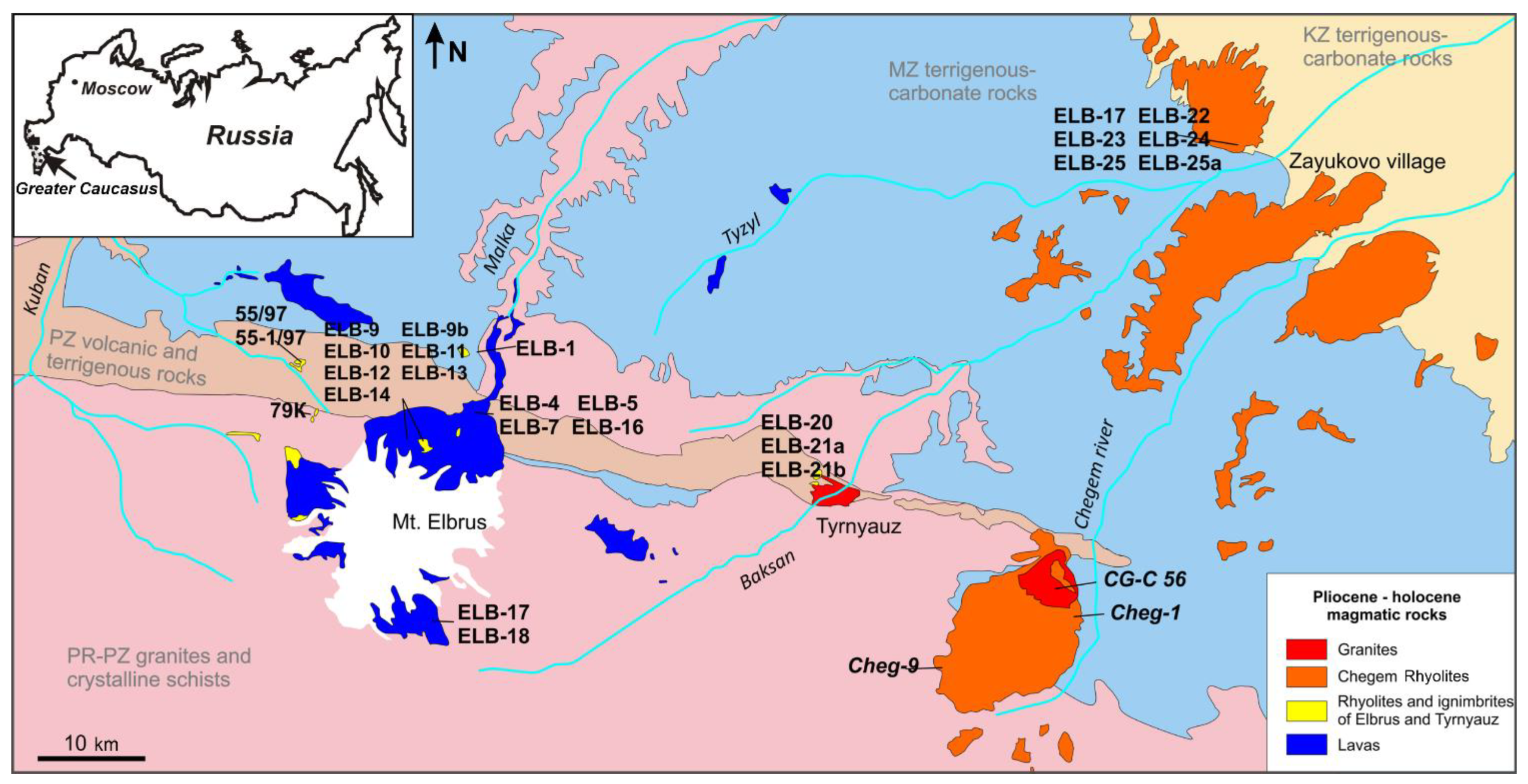
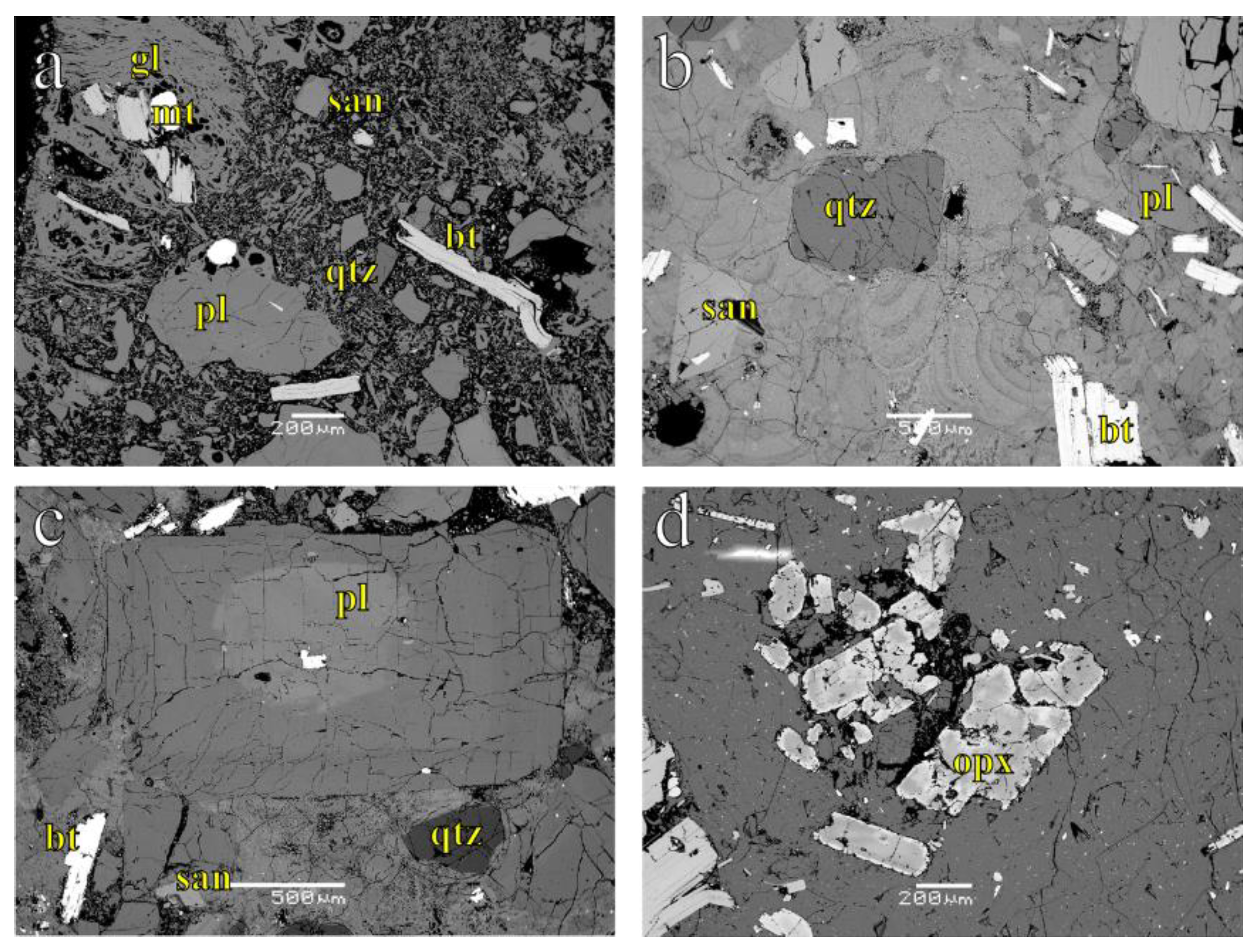
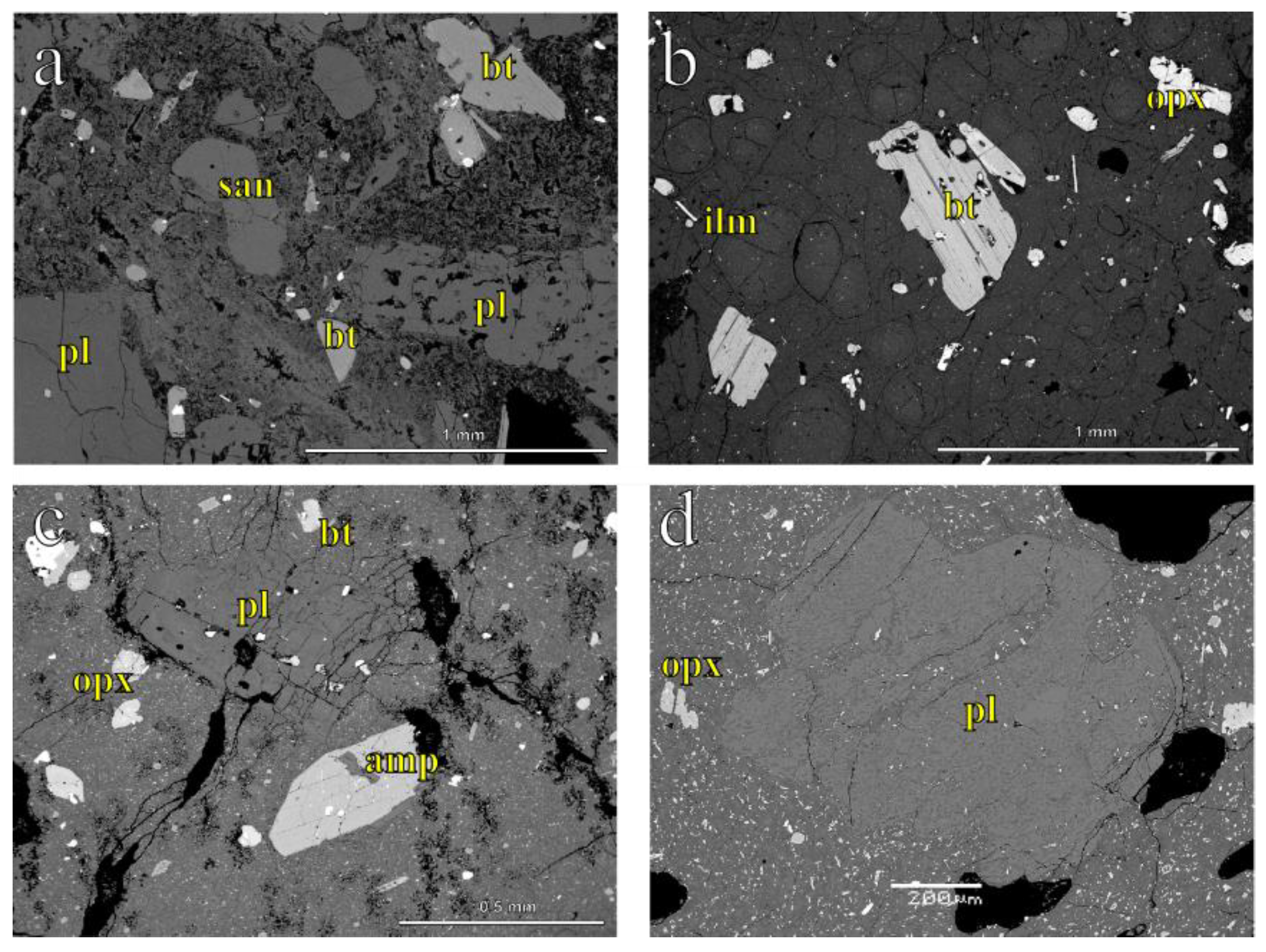
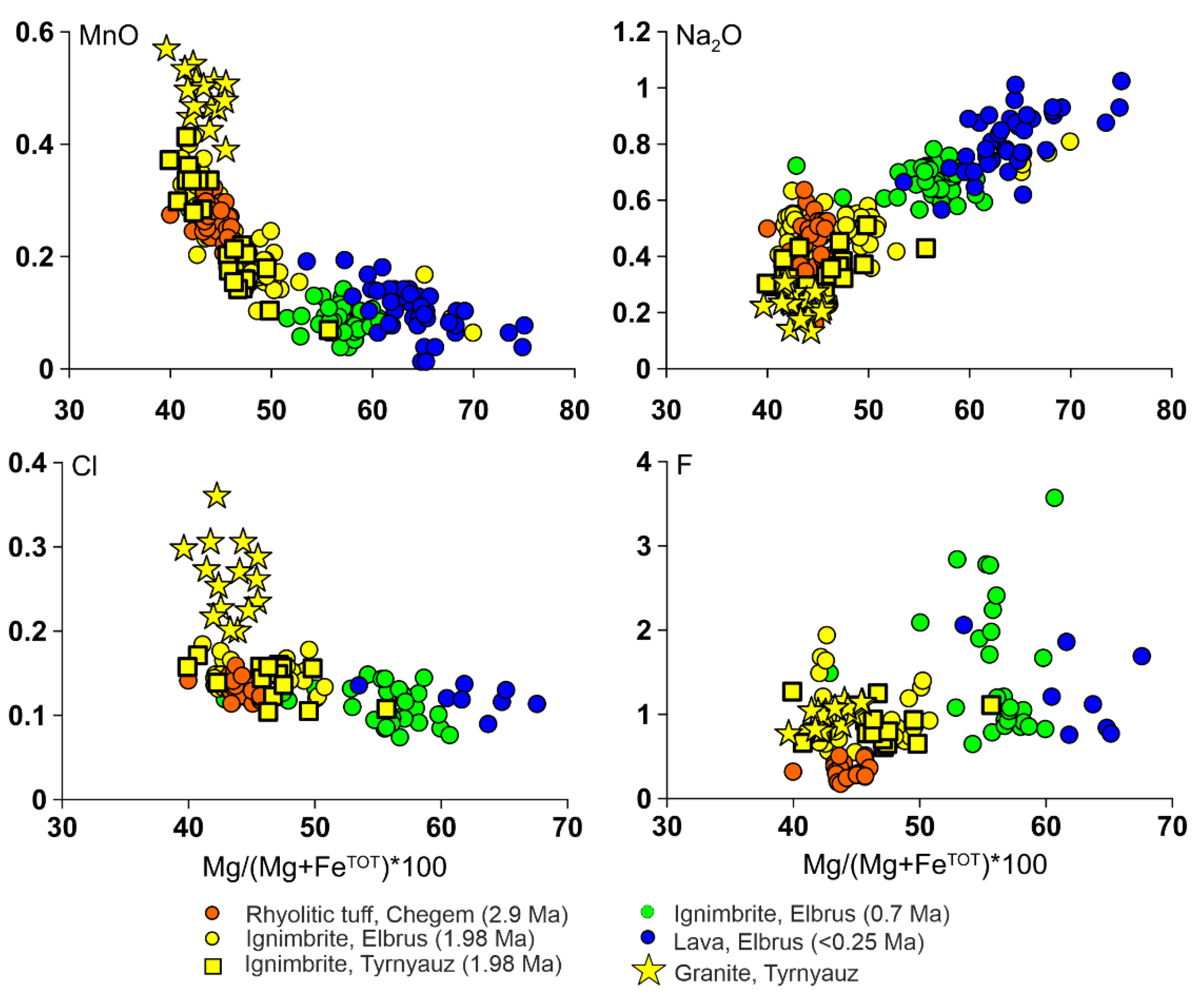
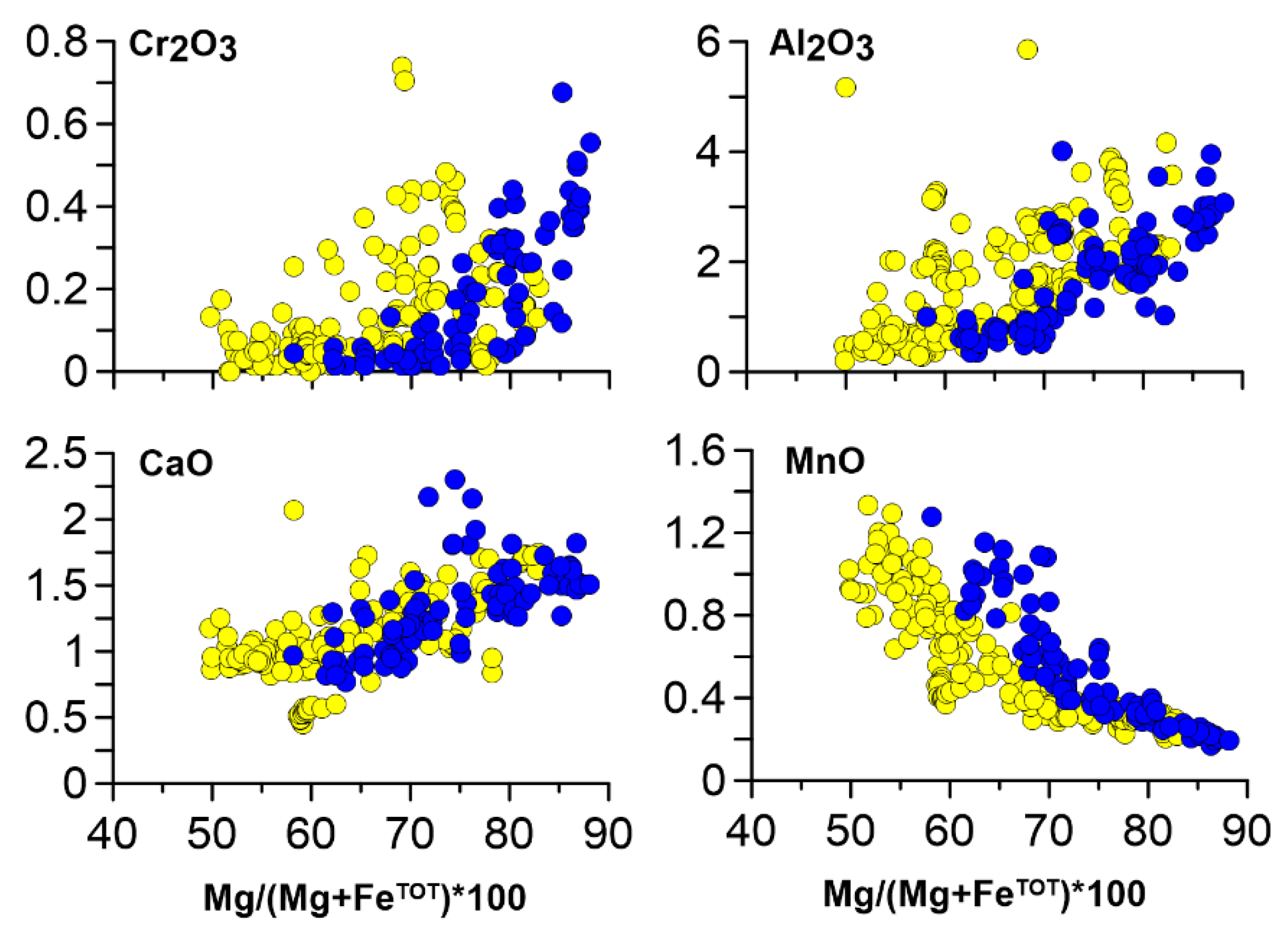
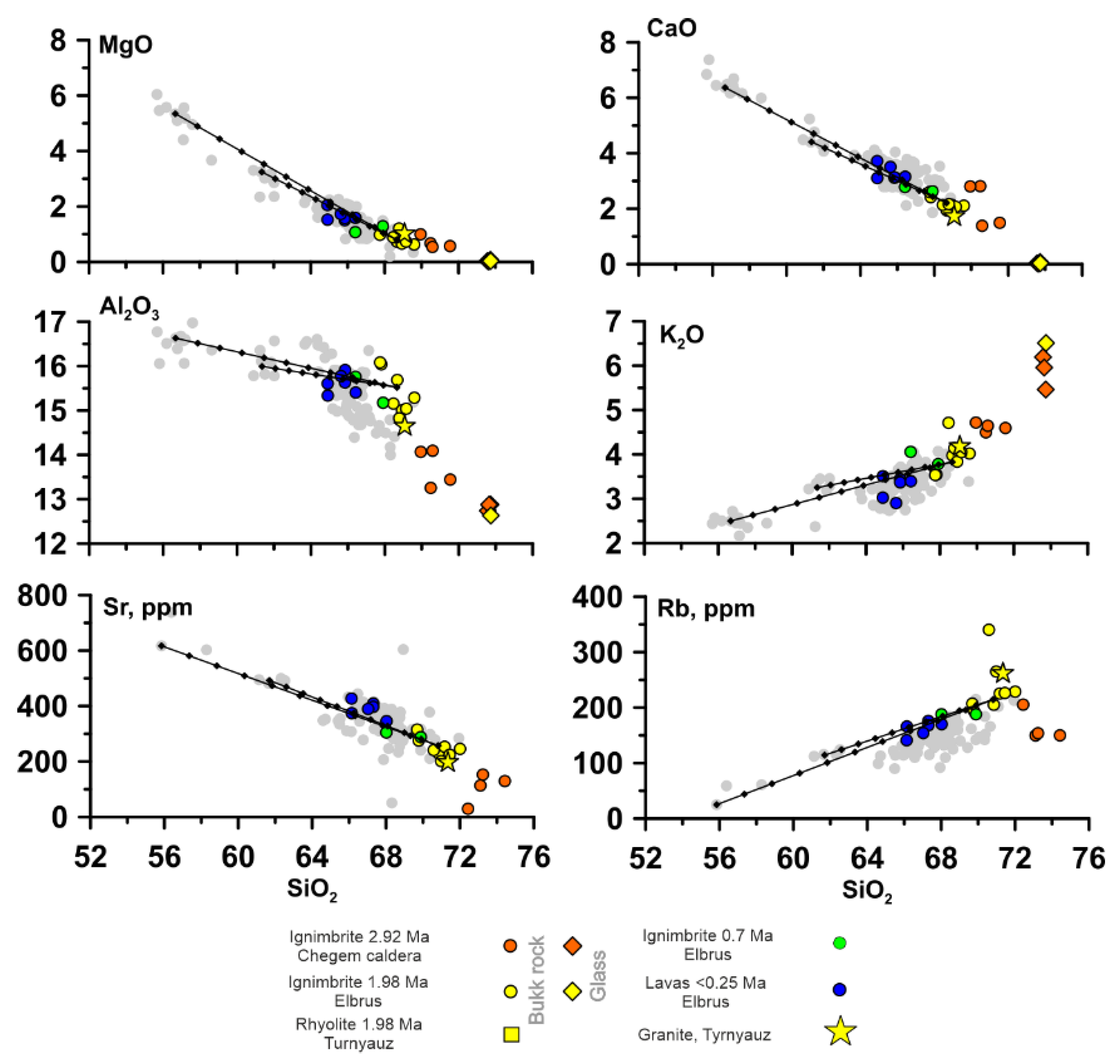
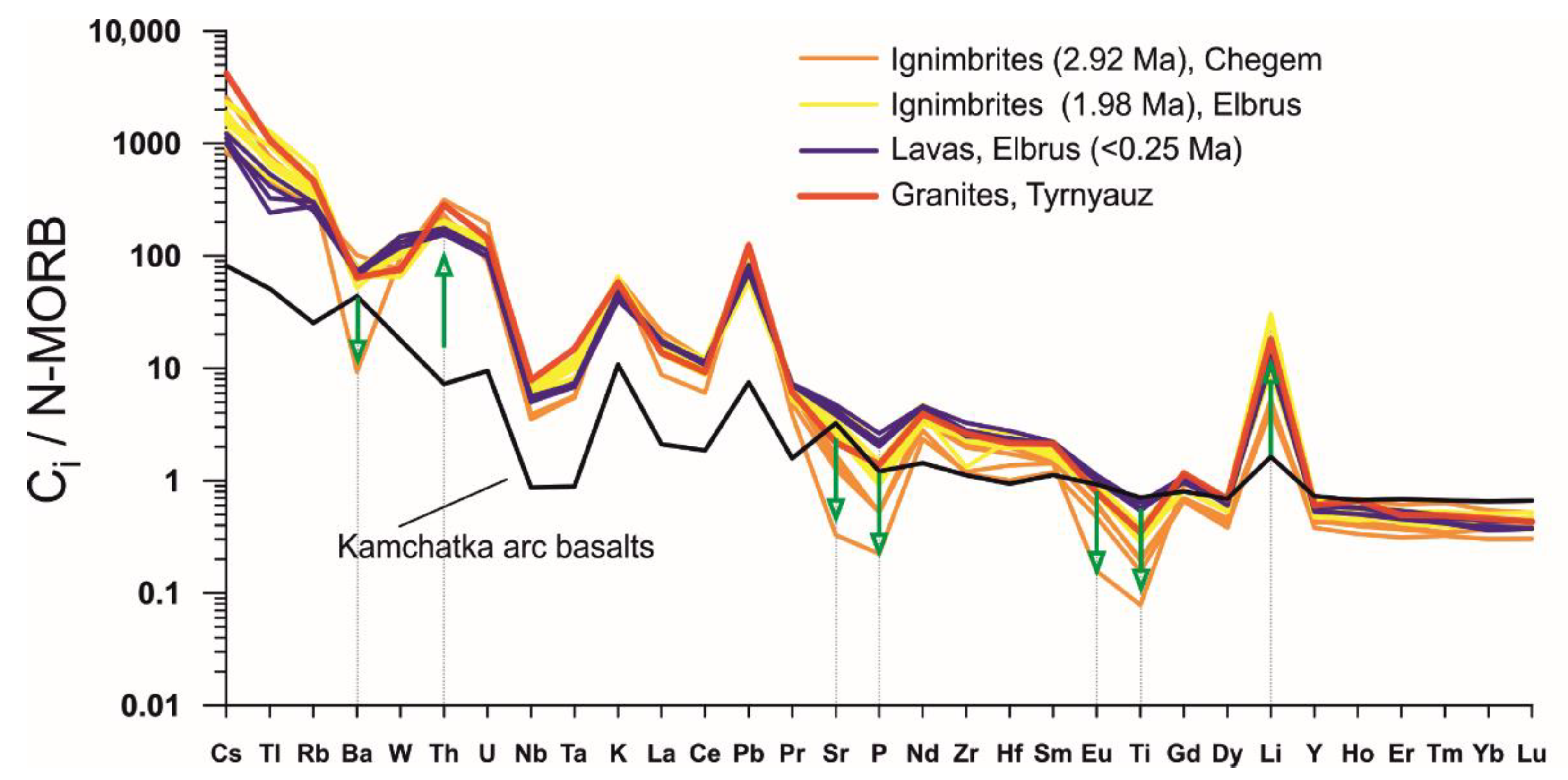
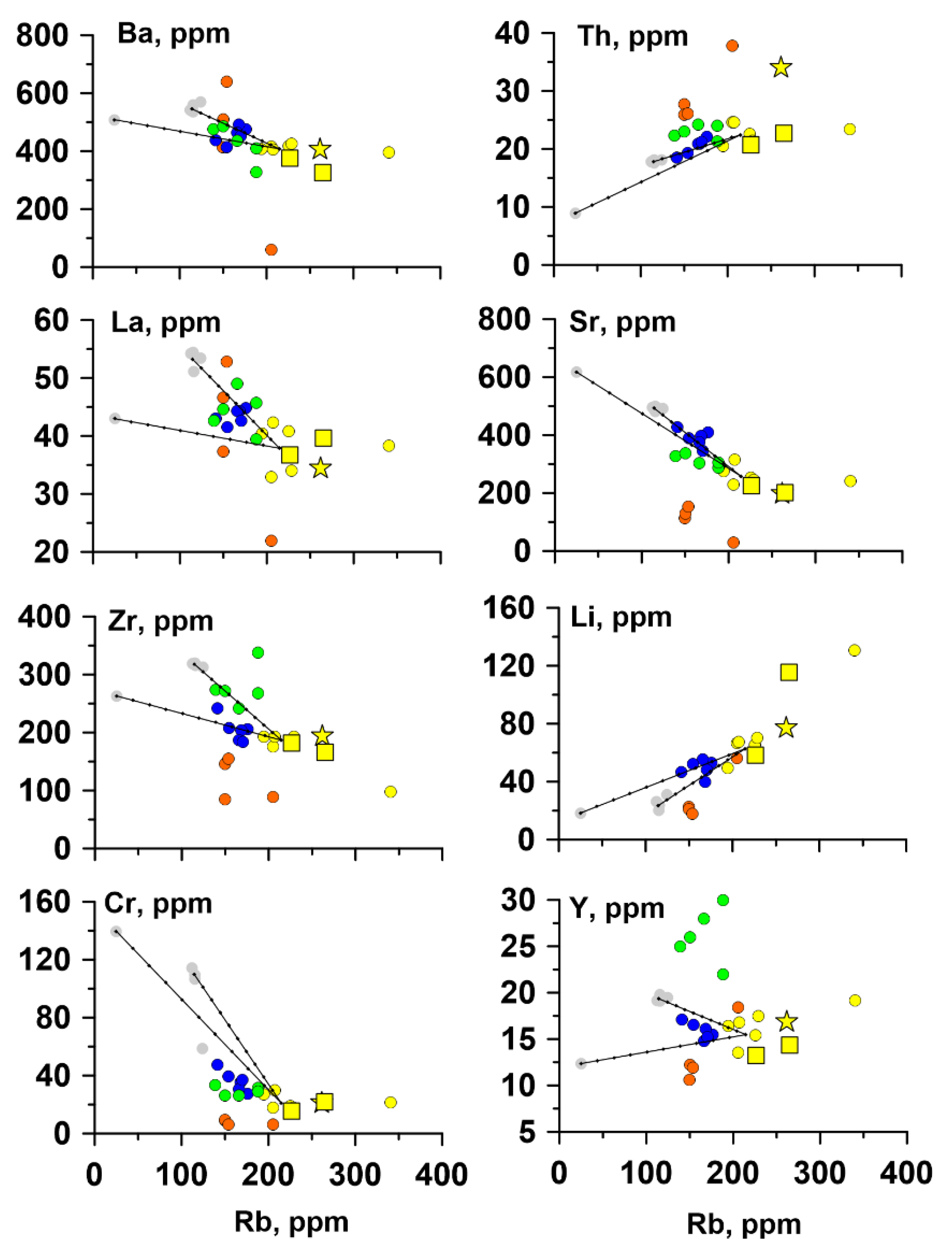
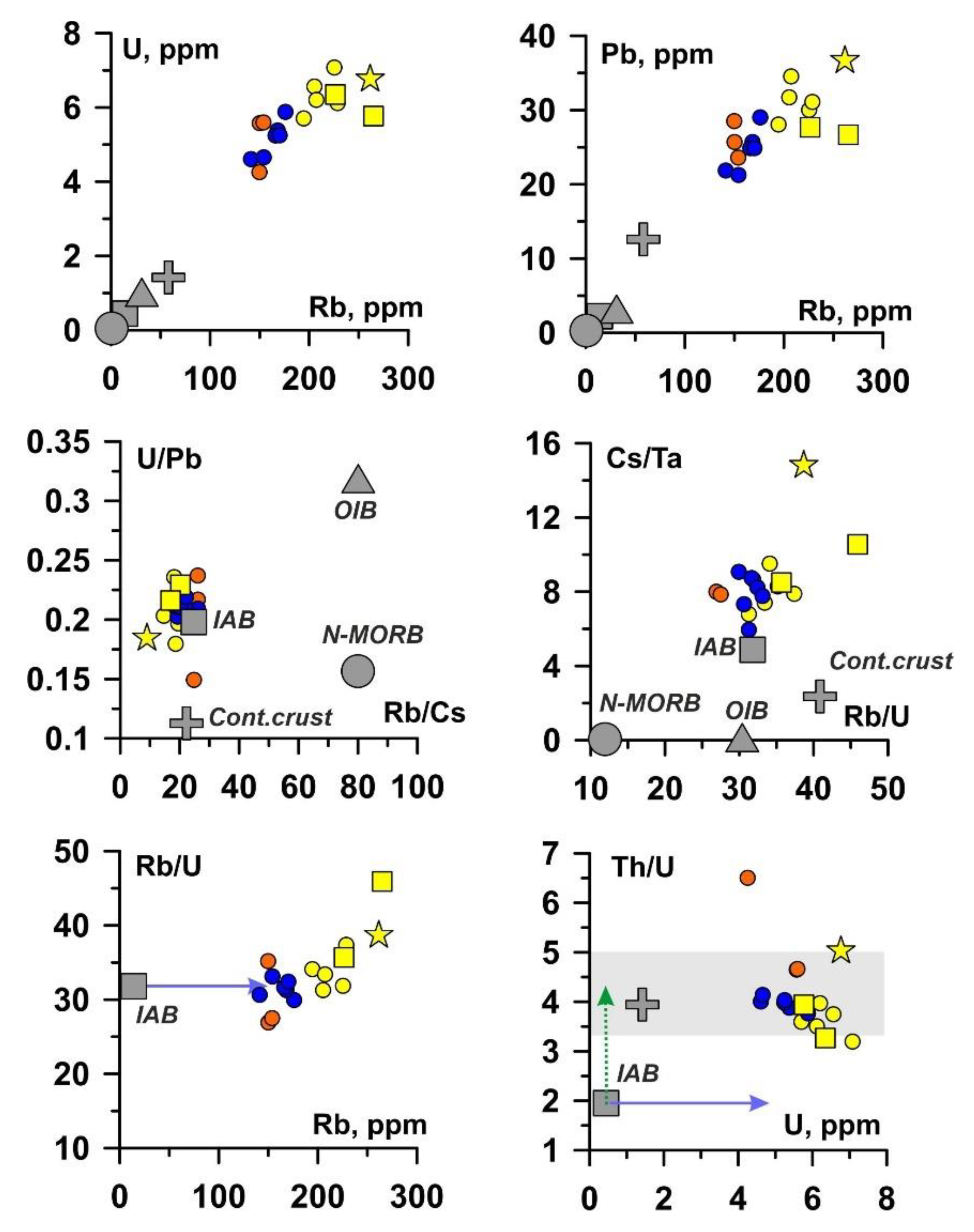
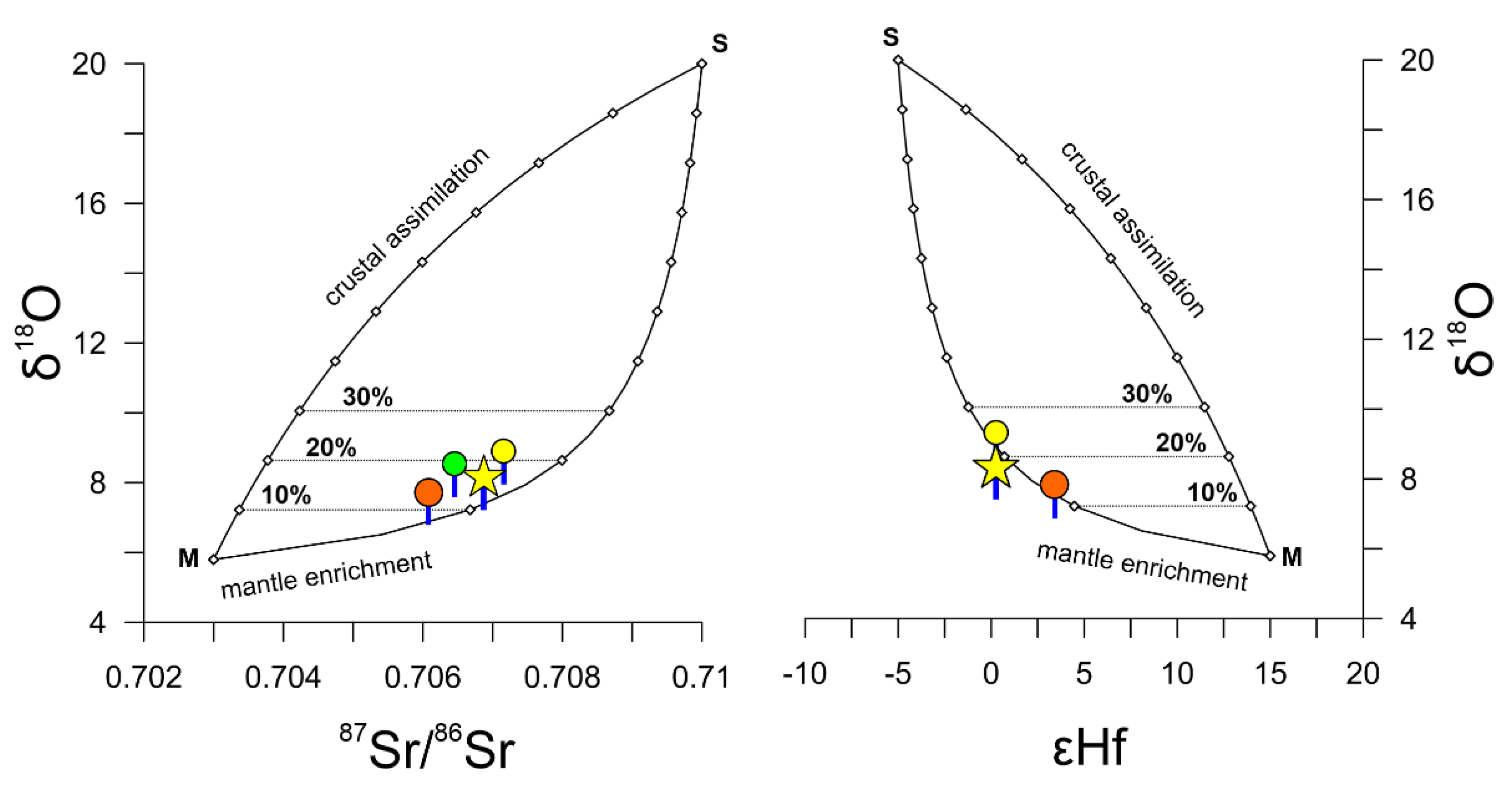
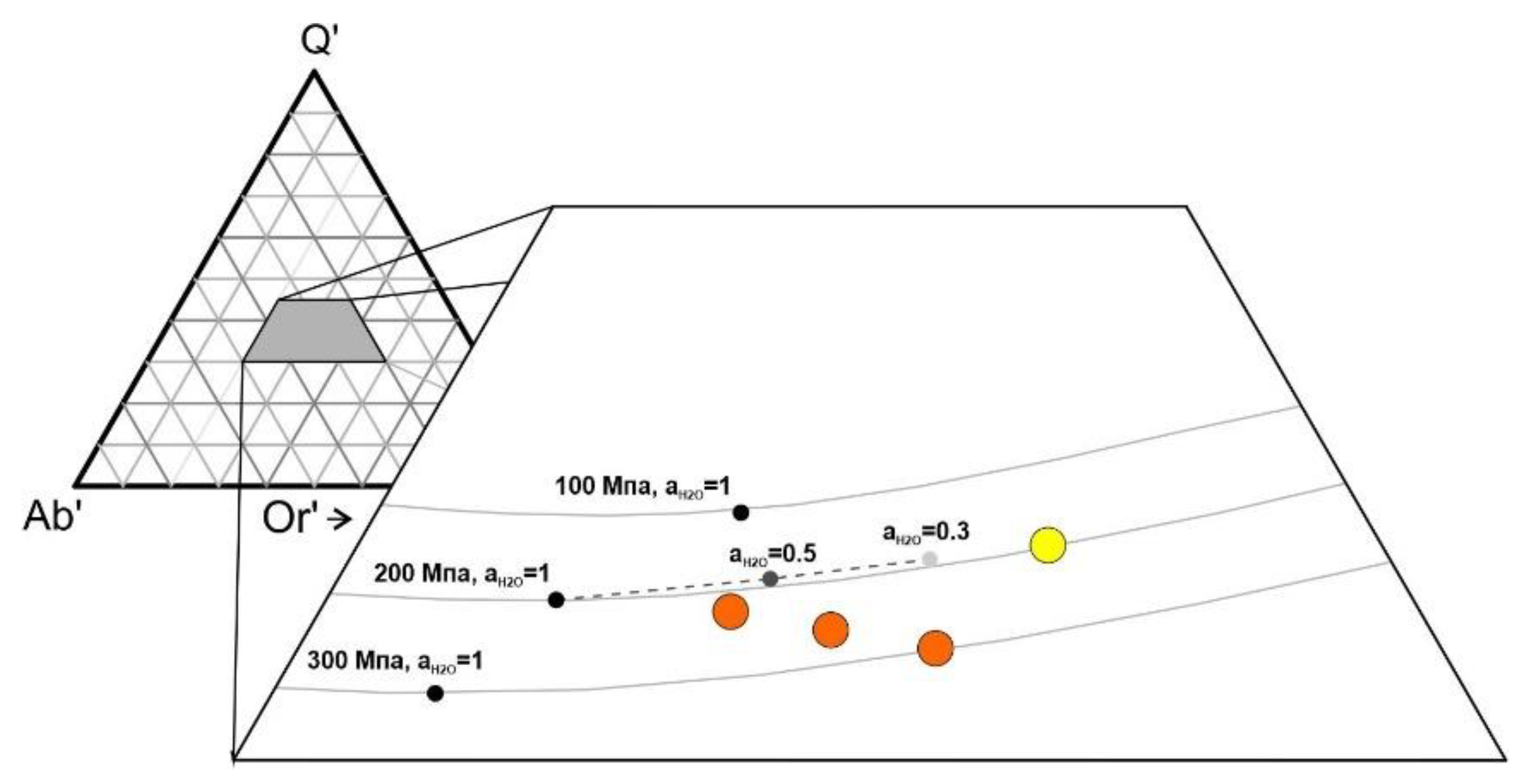
Publisher’s Note: MDPI stays neutral with regard to jurisdictional claims in published maps and institutional affiliations. |
© 2022 by the authors. Licensee MDPI, Basel, Switzerland. This article is an open access article distributed under the terms and conditions of the Creative Commons Attribution (CC BY) license (https://creativecommons.org/licenses/by/4.0/).
Share and Cite
Shcherbakov, V.; Bindeman, I.; Gazeev, V. Geochemical, Isotopic and Petrological Constraints on the Origin and Evolution of the Recent Silicic Magmatism of the Greater Caucasus. Minerals 2022, 12, 105. https://doi.org/10.3390/min12010105
Shcherbakov V, Bindeman I, Gazeev V. Geochemical, Isotopic and Petrological Constraints on the Origin and Evolution of the Recent Silicic Magmatism of the Greater Caucasus. Minerals. 2022; 12(1):105. https://doi.org/10.3390/min12010105
Chicago/Turabian StyleShcherbakov, Vasily, Ilya Bindeman, and Viktor Gazeev. 2022. "Geochemical, Isotopic and Petrological Constraints on the Origin and Evolution of the Recent Silicic Magmatism of the Greater Caucasus" Minerals 12, no. 1: 105. https://doi.org/10.3390/min12010105
APA StyleShcherbakov, V., Bindeman, I., & Gazeev, V. (2022). Geochemical, Isotopic and Petrological Constraints on the Origin and Evolution of the Recent Silicic Magmatism of the Greater Caucasus. Minerals, 12(1), 105. https://doi.org/10.3390/min12010105




